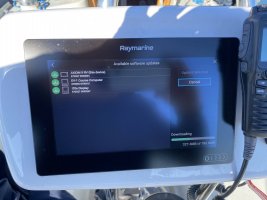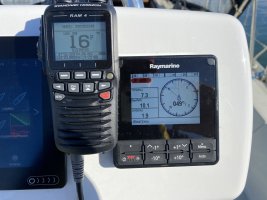I was sailing along the other day, with my wheel-pilot driving. Suddenly the system started beeping. I bought this special loud alarm for my network for AIS wake-ups, so really it wasn't beeping, it was screaming bloody murder at me.
"No Pilot!" "No Pilot!" but of course there was a pilot, it had just been driving.
Made it home steering all by myself (I know, right? Knox Johnston stuff). Some googling showed that one possible cause was the need for a software update. I did that via the Axiom and my iphone as hotspot today. It seems to have fixed the problem.

Another thing I have recently learned / discovered figured out:
In the stand-alone EV-100 installation, the system knows what direction the boat is going, from the EV-1 compass, and what compass bearing the user wants the pilot to hold. That's all. If the wind shifts enough and one doesn't trim his sails, the system may eventually be unable to hold a course and will beep and go crazy and shut down.
With a Raymarine wind instrument at the top of the mast, all of a sudden the system has more information about the direction of the wind. With a speed input (from GPS or a paddlewheel) the system can now sort out true and apparent wind.
Once my network knew what direction the wind is blowing, it allowed me to use the 'Wind Vane' mode, were instead of steering to a compass bearing, I could input a heading relative to the direction of the wind. More like how a mechanical wind vane would work.

What's the application? Kind of gilding the lily I guess. You go below for a bit and the wind shifts. With wind-vane steering, the boat will continue blowing along. With compass bearing inputs, the boat may struggle to hold a fixed course as the sails go out of trim.
In any case, if you have the wind instrument on your network, your wheel pilot will be able to do this.
"No Pilot!" "No Pilot!" but of course there was a pilot, it had just been driving.
Made it home steering all by myself (I know, right? Knox Johnston stuff). Some googling showed that one possible cause was the need for a software update. I did that via the Axiom and my iphone as hotspot today. It seems to have fixed the problem.

Another thing I have recently learned / discovered figured out:
In the stand-alone EV-100 installation, the system knows what direction the boat is going, from the EV-1 compass, and what compass bearing the user wants the pilot to hold. That's all. If the wind shifts enough and one doesn't trim his sails, the system may eventually be unable to hold a course and will beep and go crazy and shut down.
With a Raymarine wind instrument at the top of the mast, all of a sudden the system has more information about the direction of the wind. With a speed input (from GPS or a paddlewheel) the system can now sort out true and apparent wind.
Once my network knew what direction the wind is blowing, it allowed me to use the 'Wind Vane' mode, were instead of steering to a compass bearing, I could input a heading relative to the direction of the wind. More like how a mechanical wind vane would work.

What's the application? Kind of gilding the lily I guess. You go below for a bit and the wind shifts. With wind-vane steering, the boat will continue blowing along. With compass bearing inputs, the boat may struggle to hold a fixed course as the sails go out of trim.
In any case, if you have the wind instrument on your network, your wheel pilot will be able to do this.
